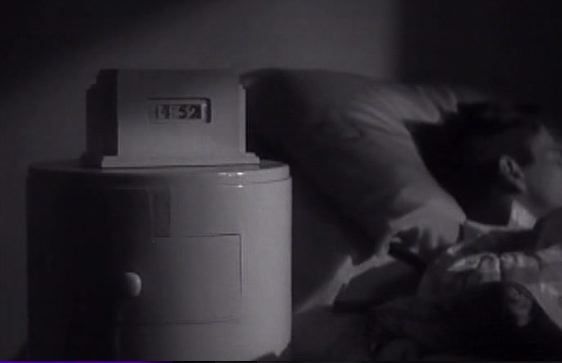
"Well, I suppose we've got to have architects too. If I wanted to build a nice, cozy, unpretentious insane asylum, he'd be the man for it." - Newlywed David Manners (Peter Alison) regarding his host, in The Black Cat.
Though it casts a villain of an architect, (Boris Karloff, as "Hjalmar Poelzig", named after the actual, prominent modern architect Hans Poelzig who director Edgar Ulmer claimed once to have worked for); The Black Cat, which features a machine-age mansion with brightly lit strip-windows standing in for the familiar medieval, crenellated-towered castle at the top of a misty, winding mountain road; starkly cold and beautiful interiors that borrow from Russian Constructivism (angled walls), German Expressionism (steeply raked views to deeply shadowed cellar stairs), American, Raymond Loewy-esque streamlining (curvilinear handrails, sliding pocket doors, neon-adorned & accentuated speaker grilles), and French Art Decoratif, (back-lit glass block, Eileen Gray-esque tubular chrome furniture, polished terrazzo floors), THE up-front-and-center star of the show is surely the architectural, interior, decorative and industrial design.
But snide comments aside, even by the writer-director-set designer, there's no doubt that this one-and-the-same, Edgar Ulmer, loved the sources he was borrowing from.
There is, tellingly, an alternate explanation in the narrative for the proof of the character's turpitude: during the Great War, he was responsible for the deaths of 10,000 men and built his austerely antiseptic abode on their graves. Near the end, Karloff takes his place on a podium that incorporates in its canted design a simulacrum of WWI chaos & devastation.
And like much postwar art, the plot ends with the whole place exploding, in back-looking views, seen by our escaping heroes, that seem deliberately to evoke the bombed-out fields of that war that, by the 1930s would be familiar to audiences, and scary for reasons not at all supernatural!
The naming of the film for the dark domesticated pet has only a tenuous connection to the film's plot or story. It's the architecture - whether sinister in its chimerical clinicality, or glamorous in its sleek secretiveness - that earns our eager attention, and the stretched, but fair analogy to ...... The Black Cat.
The mansion at the top of the winding, misty road, built on the graves of sacrificed soldiers -
The shot above bleeds into the shot below - with the winding staircase overlapping the road:
Dig the flush-mounted, continuously-lit ceiling panels -
A sliding, pocket front door with oversized grip handle
A speaker with non-functional fins and a neon light -
That's some nice bowl of water to wash your hands in -
Lever-handled door pull on flush-mounted metal panel
Enjoy the clock -
or is it a radio?
Our young hero uses a remote-controlled light switch -
A digital clock ! -
The drawer is completely flush with the body of the night-table -
To the cellar -
A podium of planned cacophony -
The place explodes from a safe distance ....







































No comments:
Post a Comment